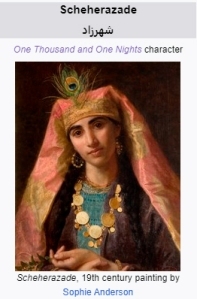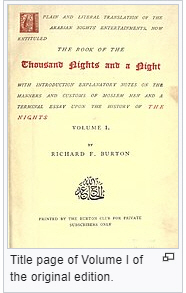Scheherazade
 Scheherazade, the teller of the tales in The Book of the Thousand Nights and a Night, captured my imagination when I was in junior high school. The stories are fascinating. So was the idea of the narrator telling one story per night–but never quite ending it–to keep the king from killing her when a tale ends which he had threatened to do. Or perhaps it was her name that drew me in and never let me go.
Scheherazade, the teller of the tales in The Book of the Thousand Nights and a Night, captured my imagination when I was in junior high school. The stories are fascinating. So was the idea of the narrator telling one story per night–but never quite ending it–to keep the king from killing her when a tale ends which he had threatened to do. Or perhaps it was her name that drew me in and never let me go.
My parents are at fault because they gave me a copy of the book as a gift for Christmas or my birthday. It’s around here somewhere. Suffice it to say, it wasn’t the definitive 1880s translation from Richard Burton (1821–1890) which filled many volumes and might still be the only complete English translation.
 I also had a copy of Rimsky-Korsakov’s 1888 symphonic suite “Scheherazade” based on the story. I had it on vinyl. It’s also around here somewhere, though I probably wore all the grooves off. My copy is older than the version shown here.
I also had a copy of Rimsky-Korsakov’s 1888 symphonic suite “Scheherazade” based on the story. I had it on vinyl. It’s also around here somewhere, though I probably wore all the grooves off. My copy is older than the version shown here.
I still like the stories now, many years after I first read them, and wonder how many high school and college students study the book anymore. I hope they do, for though it comes from another time, place, and culture, it presents stories that demand our attention and that keeps us reading–rather like the king who fell in love with Sheherazade (sparing her life) while she was telling her stories every night.
from the Publisher (current edition) “THE BOOK OF THE Thousand Nights and a Night VOLUME V Translated by RICHARD F. BURTON Limited to one thousand numbered sets 1885 (London “Burton Club” edition), illustrated The Book of the Thousand Nights and a Night (1885), subtitled “A Plain and Literal Translation of the Arabian Nights Entertainments”, is a celebrated English language translation of “One Thousand and One Nights” (the “Arabian Nights”) – a collection of Middle Eastern and South Asian stories and folk tales compiled in Arabic during the Islamic Golden Age (8th−13th centuries) – by the British explorer and Arabist Richard Francis Burton (1821–1890). It stood as the only complete translation of the Macnaghten or Calcutta II edition (Egyptian recension) of the “Arabian Nights” until 2008. “One Thousand and One Nights” (Arabic: كِتَاب أَلْف لَيْلَة وَلَيْلَة kitāb ʾalf layla wa-layla) is a collection of Middle Eastern and South Asian stories and folk tales compiled in Arabic during the Islamic Golden Age. It is often known in English as the Arabian Nights, from the first English language edition (1706), which rendered the title as The Arabian Nights’ Entertainment. The work was collected over many centuries by various authors, translators, and scholars across West, Central, and South Asia and North Africa. The tales themselves trace their roots back to ancient and medieval Arabic, Persian, Mesopotamian, Indian, Jewish and Egyptian folklore and literature. In particular, many tales were originally folk stories from the Caliphate era, while others, especially the frame story, are most probably drawn from the Pahlavi Persian work Hazār Afsān (Persian: هزار افسان, lit. A Thousand Tales) which in turn relied partly on Indian elements. Initial frame story of the ruler Shahryār (from Persian: شهريار, meaning “king” or “sovereign”) and his wife Scheherazade, (from Persian: شهرزاد, possibly meaning “of noble lineage”), and the framing device incorporated throughout the tales themselves. The stories proceed from this original tale; some are framed within other tales, while others begin and end of their own accord. The bulk of the text is in prose, although verse is occasionally used for songs and riddles and to express heightened emotion. Most of the poems are single couplets or quatrains, although some are longer.”
“THE BOOK OF THE Thousand Nights and a Night VOLUME V Translated by RICHARD F. BURTON Limited to one thousand numbered sets 1885 (London “Burton Club” edition), illustrated The Book of the Thousand Nights and a Night (1885), subtitled “A Plain and Literal Translation of the Arabian Nights Entertainments”, is a celebrated English language translation of “One Thousand and One Nights” (the “Arabian Nights”) – a collection of Middle Eastern and South Asian stories and folk tales compiled in Arabic during the Islamic Golden Age (8th−13th centuries) – by the British explorer and Arabist Richard Francis Burton (1821–1890). It stood as the only complete translation of the Macnaghten or Calcutta II edition (Egyptian recension) of the “Arabian Nights” until 2008. “One Thousand and One Nights” (Arabic: كِتَاب أَلْف لَيْلَة وَلَيْلَة kitāb ʾalf layla wa-layla) is a collection of Middle Eastern and South Asian stories and folk tales compiled in Arabic during the Islamic Golden Age. It is often known in English as the Arabian Nights, from the first English language edition (1706), which rendered the title as The Arabian Nights’ Entertainment. The work was collected over many centuries by various authors, translators, and scholars across West, Central, and South Asia and North Africa. The tales themselves trace their roots back to ancient and medieval Arabic, Persian, Mesopotamian, Indian, Jewish and Egyptian folklore and literature. In particular, many tales were originally folk stories from the Caliphate era, while others, especially the frame story, are most probably drawn from the Pahlavi Persian work Hazār Afsān (Persian: هزار افسان, lit. A Thousand Tales) which in turn relied partly on Indian elements. Initial frame story of the ruler Shahryār (from Persian: شهريار, meaning “king” or “sovereign”) and his wife Scheherazade, (from Persian: شهرزاد, possibly meaning “of noble lineage”), and the framing device incorporated throughout the tales themselves. The stories proceed from this original tale; some are framed within other tales, while others begin and end of their own accord. The bulk of the text is in prose, although verse is occasionally used for songs and riddles and to express heightened emotion. Most of the poems are single couplets or quatrains, although some are longer.”
 These stories took me to another world as did the music. Take a look and you might have a similar experience though not with my obsession. I do believe these stories are “must-reading” because they are a strong component of the world’s literary heritage–as are the Shakespeare plays–and demand our attention. That is to say, part of being a multi-genre, multi-cultural, reader is to dip one’s toe (if not more) into the stories spun by Scheherazade and know more of the world outside our neighborhoods.
These stories took me to another world as did the music. Take a look and you might have a similar experience though not with my obsession. I do believe these stories are “must-reading” because they are a strong component of the world’s literary heritage–as are the Shakespeare plays–and demand our attention. That is to say, part of being a multi-genre, multi-cultural, reader is to dip one’s toe (if not more) into the stories spun by Scheherazade and know more of the world outside our neighborhoods.
–Malcolm



